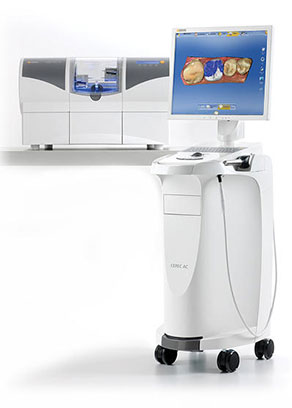Same Day Crowns

Cerec Omnicam is the latest generation of Digital CAD/CAM machines which allows for the fabrication of same day crowns and esthetic porcelain veneers without the need for impressions, temporary crowns and dental laboratories
Do you recall a crown or crowns you've had made at your dentist's office where a tooth was numbed and shaped, an impression was taken, a temporary crown was cemented and then you left the office? You had to return to the office in two or three weeks to have the crown fitted and cemented to the tooth. Did you have any problems or sensitivity with the temporary crown?
Unlike this traditional method, Cerec uses a combination of infrared imaging, computer CAD CAM design and a precise milling machine to help complete the entire process is about 2 hours from start to finish - all in one appointment!
We have taken the time and considerable effort over the past ten years to hone our skill in this technically demanding treatment modality so that 99% of all our Cerec same day crowns are accomplished in one appointment.
Why would you want a Cerec same day crown instead of a conventional one?
- Less time in the dental chair - half the number of appointments; fewer local anesthetic episodes.
- Less tooth structure is lost in most cases. We can make most of the preparations for these crowns without cutting away as much of your natural tooth.
- Many lab crowns have a metal substrate that porcelain is bonded to. Cerec crowns are all porcelain - this means lower chances of allergic or immune response to the material in the crown.
- Cost is the same in our office for either type of crown.
- Less chance for complications - most temporary restorations leak or have other discrepancies that can sometimes lead to increased sensitivity and this can even create the need for further treatment such as root canal therapy. When the crown is started and finished in one appointment, the tooth structure is better sealed off and protected at an earlier stage with the result that risk of complications and/or sensitivity can be lowered.
- Cerec is patient friendly! Once the design process begins, you are free to move about the office, make phone calls, run a short errand or even have additional dentistry such as a couple of fillings done - further shortening the number of visits you might need. There is a time frame of about 20 to 30 minutes in the middle of the appointment where the crown unit is being designed/fabricated and your presence is not needed unless you elect to have other needed treatment accomplished in that time slot.
- Cerec is GREEN (environmentally friendly), it is efficient and it SAVES you MONEY ($).
How does it work?
An infrared camera takes images of the tooth after shaping and a CAD CAM computer program immediately downloads the images creating three-dimensional virtual models that can be viewed and manipulated on the computer monitor. The operator in the dental office then uses the program to design the crown or onlay that will replace the missing tooth structure. This usually takes about three to five minutes. Next a porcelain block is selected, is inserted into a milling machine and the software program sends a signal to the milling machine to create the design in porcelain. This takes about 13 to 18 minutes. Once completed, the crown is polished, tried in the mouth, adjusted and bonded into place. The entire process takes about 2 hours and there is a period of about ½ hour for design and milling that can be used to accomplish other needed dental work.
How does it compare to conventional crowns?
The process of manufacturing a metal base lab crown involves significant amounts of expensive consumable materials beginning with impression materials in the dental office, continuing through model making devices and materials and on to alloys of metal that are increasingly costly followed by use of firing ovens, casting machines and the like. Most of these materials are not particularly biodegradable. With Cerec, there is a very limited amount of disposable material needed. This helps lower the waste stream, much of it carbon footprint related, as well as the cost.
Are there any drawbacks or contradictions to Cerec crowns?
This technology can be used almost all single crowns. Sometimes where aesthetic results are a high priority, an exact color match of surrounding teeth can be difficult and in these cases a laboratory technician may be able to produce better aesthetics with a laboratory fabricated and stained crown. At the present time, we are not able to build bridges in one appointment with Cerec. In almost all other cases, we would confidently recommend a Cerec crown in place of a laboratory-fabricated crown.

